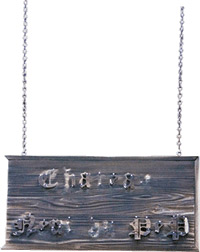

Monday - March 31, 2008
SLAC Today is
available online at:
http://today.slac.stanford.edu
In this issue:
symmetry: Chateau Neuf du PEP
Colloquium Monday: Quantum Computing
New and Improved Capabilities for Biological Small Angle X-ray Scattering at SSRL
 |
 |
|
Monday - March 31, 2008 |
 symmetry: Chateau Neuf du PEPNo one is able to claim credit for the ancient wooden sign that hangs on the porch of the old Positron Electron Project buildings at SLAC. The sign, proclaiming the area "Chateau Neuf du PEP," is a play on the wine they used to drink there. Châteauneuf du Pape is a wine appellation in southern France, named for Pope John XXII's 14th century summer "new home." "Those were quite different days," says Perry Wilson, a senior scientist on PEP at the time. During the '70s, when the sign went up, PEP collaborators would gather every Friday for refreshments, music, and dancing. Wilson played the gutbucket, a homemade bass. Châteauneuf du Pape, a thick, powerful red wine, was a favorite libation. Perhaps all that wine addled their memories. Regarding the sign, Wilson points a finger at Francophile John Rees. But Rees, who was director of PEP, denies responsibility. Phil Morton, who was part of PEP's design team, said, "It sounds like something I might have done. I'd like to take credit for it but, I just don't know." The wine no longer flows, but the well-weathered sign remains, an anonymous monument to the tastes and humor of the old PEP gang. |
||
|
|
||

Quantum Computing
Imagine a game where two players go back and forth making moves and at the end of a fixed number of moves the position is either a win or a loss for the first player. In this case, if both players play perfectly, it is determined at the first move who wins or loses. To figure out who will be the winner you need not look at all of the N final positions but only at N0.753. This afternoon, Farhi will show that with a quantum computer the exponent can be reduced to 0.5. The technique involves quantum scattering theory and illustrates how ideas from physics can be used to design quantum algorithms that outperform even best possible classical algorithms. The colloquium will take place at 4:15 p.m. today in Panofsky Auditorium. All are invited to attend. |
New and Improved Capabilities for Biological Small Angle X-ray Scattering at SSRL
Stanford Synchrotron Radiation Laboratory (SSRL) staff have been making steady progress on the long-awaited Beamline 4 upgrade. The 20-pole wiggler was relocated to Sector 16 in Building 130 during the 2007 summer shutdown. This schedule allowed the Beamline 4-2 end station to remain open for Biological Applications of Small Angle X-ray Scattering (BioSAXS) experiments until the end of the FY07 user run, minimizing the down time for this user community. The experimental enclosures (hutches), constructed prior to the relocation, are now being rapidly filled with a new set of optics and improved BioSAXS instrumentation. The new Beamline 4-2, anticipated to be operational by summer 2008, will provide at least 10 times higher flux at a ring current of 500 mA, with smaller beam size and enhanced stability. |
Events
Access (see all)Announcements
|
| | ||
|
|
||
 <%
Response.AddHeader "Last-modified", getArticleDate()
'Response.AddHeader "Last-modified","Mon, 01 Sep 1997 01:03:33 GMT"
'Monday, December 06, 2010
%>
<%
Response.AddHeader "Last-modified", getArticleDate()
'Response.AddHeader "Last-modified","Mon, 01 Sep 1997 01:03:33 GMT"
'Monday, December 06, 2010
%>View online at http://today.slac.stanford.edu/. |
||